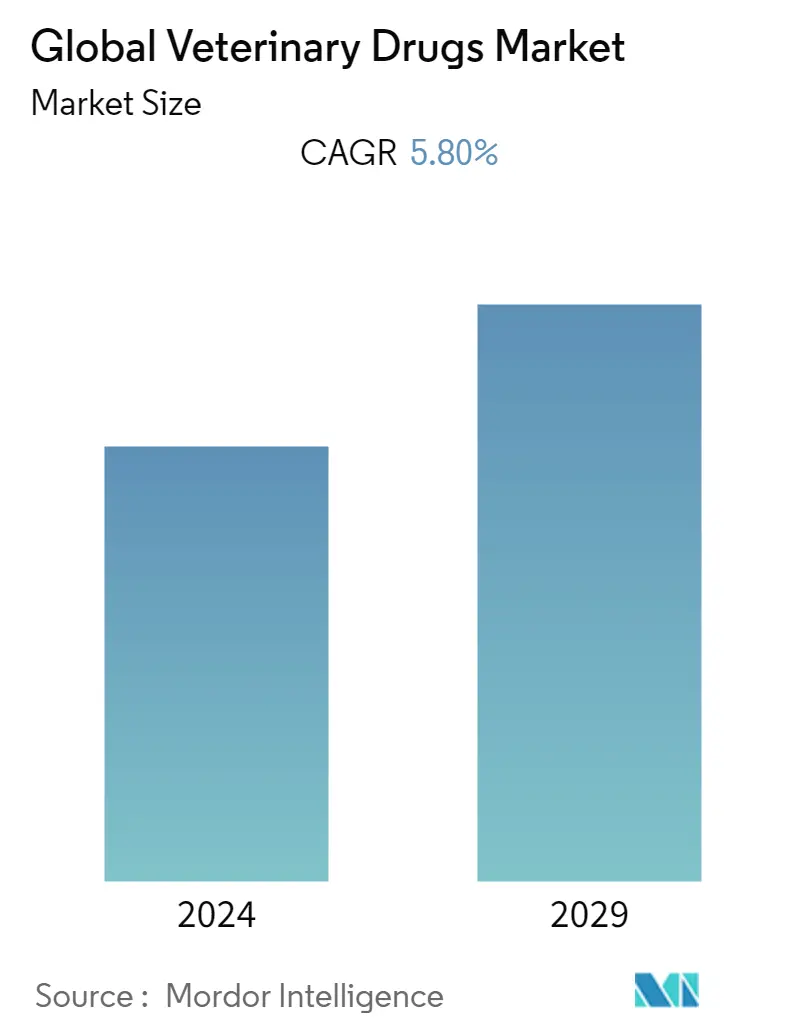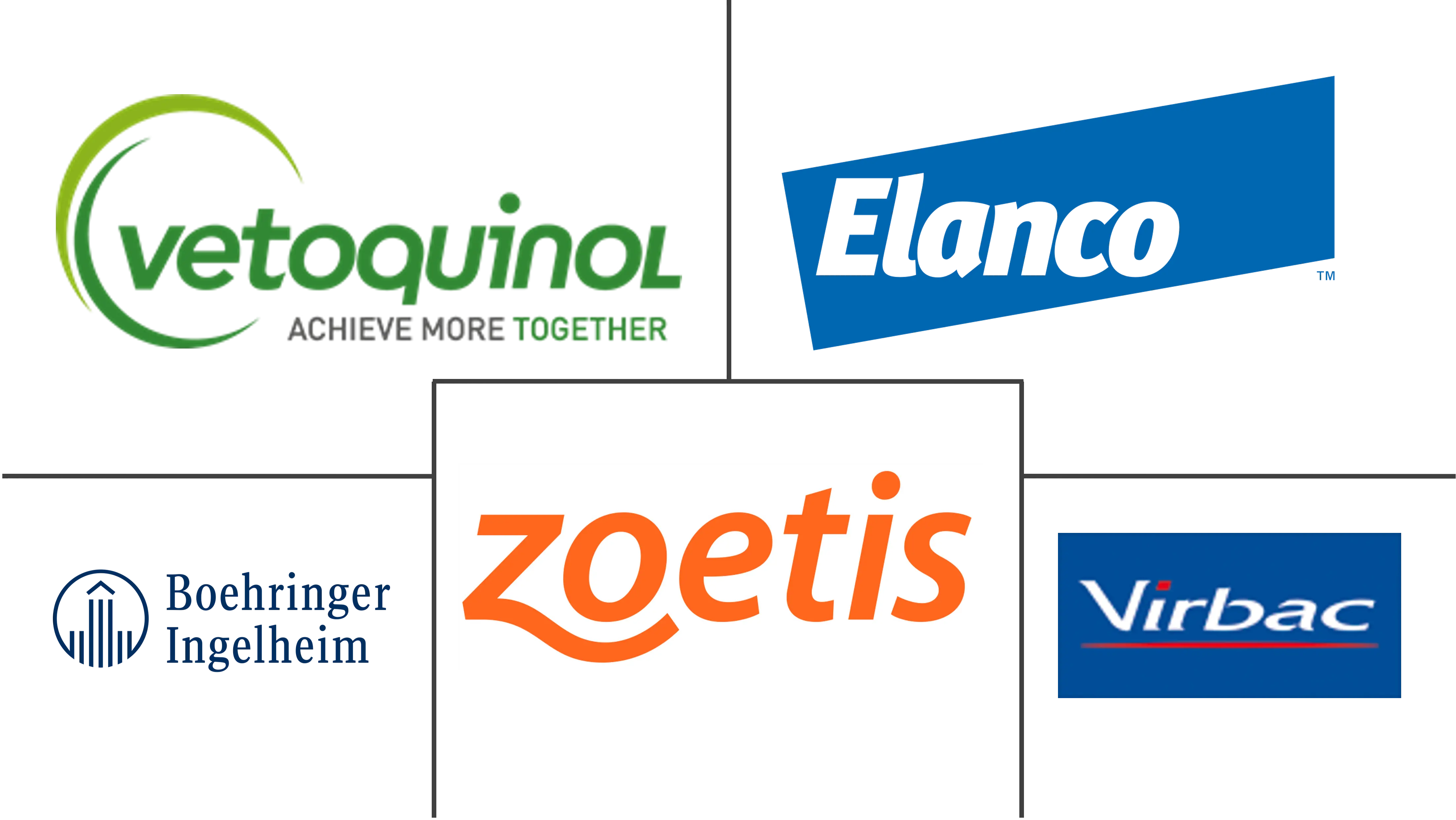Market Size of Global Veterinary Drugs Industry

| Study Period | 2019 - 2029 |
| Base Year For Estimation | 2023 |
| Forecast Data Period | 2024 - 2029 |
| CAGR | 5.80 % |
| Fastest Growing Market | Asia Pacific |
| Largest Market | North America |
Major Players
*Disclaimer: Major Players sorted in no particular order |
Veterinary Drugs Market Analysis
The Veterinary Drugs Market is expected to witness a CAGR of 5.8% during the forecast period.
The impact of COVID-19 in its initial phase was adverse owing to disruption in veterinary services worldwide. For instance, the survey conducted by the Office for the Coordination of Humanitarian Affairs (OCHA), titled "Impact of COVID-19 on the delivery of veterinary services and animal disease reporting: (May-June 2020/June-August 2020)" was published in July 2021 stated that 93% participants reported that COVID-19 negatively impacted veterinary services and 70% participants stated the difficulty for field agents in conducting surveillance activities and field investigations. The participants included national animal disease reporting officers from the field, central veterinary services officers, and laboratory officers involved in disease reporting. However, the market gained traction as treatment, elective procedures, and pet and animal adoption increased in the latter phase of the pandemic. For instance, an article titled "Did the COVID-19 Pandemic Spark a Public Interest in Pet Adoption?" was published in Frontiers in Veterinary Sciences Journal in May 2021, stated that the global relative search volume (RSV) for pet, dog, and cat adoption peaked in April and May 2020. The RSV ratio (2020/2019) for both dog and cat adoption increased by up to 250% when compared with the preceding global average RSV for the same time period. This is likely to result in rising veterinary healthcare expenditure and ultimately cause a positive impact on the veterinary drug market.
In addition, the rise in the prevalence of infectious diseases in pets and farm animals, the increasing incidence and emergence of new technologies, especially in biologics, and increased demand for meat and animal-based products in agriculture and human healthcare are actively affecting the growth of the studied market.
The outbreak of Lumpy Skin Disease (LSD), a viral disease in certain regions of the world is expected to expedite the research and development of vaccines and drugs by various companies and ultimately boost market growth during the forecast period. For instance, according to the World Organization for Animal Health's July 2022 update, outbreaks of lumpy skin disease were confirmed across continental Asia and many countries in South East Asia in 2020. Also, vaccination for LSD in cattle is currently being developed by Hester Biosciences Limited, India. The company is expected to commercially market the vaccine in FY 2021-2022 and has already secured the test permit for evaluating the safety and efficacy of the vaccine. Such outbreaks and research and development initiatives by the key market players are expected to boost the market growth.
Additionally, the innovation in veterinary drugs, increasing product approvals, along with partnerships and collaborations by key players are helping in the market growth. For instance, in August 2021, Elanco acquired Bayer Animal Health to extend its pet health product category, enhance portfolio mix transformation, and improve the balance between the farm animal and pet health product categories.
Therefore, owing to the aforementioned factors the studied market is anticipated to witness growth over the analysis period. However, the lack of veterinarians and the use of counterfeit medicines are likely to impede the market growth.
Veterinary Drugs Industry Segmentation
As per the scope of the report, veterinary drugs are used to treat numerous diseases growing in animals. Veterinary drugs such as antibiotics, antimicrobials, antihistamines, antiprotozoals, and hormones are developed in order to minimize the attack of harmful viruses and bacterial parasites in animals. The Veterinary Drugs Market is segmented by Product Type (Anti-infectives, Anti-inflammatory, Parasiticides, Vaccines, and Others), Route of Administration (Oral, Parenteral, and Topical), and Geography (North America, Europe, Asia-Pacific, Middle East and Africa, and South America). The market report also covers the estimated market sizes and trends for 17 different countries across major regions, globally. The report offers the value (in USD million) for the above segments.
| By Product Type | |
| Anti-infectives | |
| Anti-inflammatory | |
| Parasiticides | |
| Vaccines | |
| Other Types |
| By Route of Administration | |
| Oral | |
| Parenteral | |
| Topical |
| Geography | ||||||||
| ||||||||
| ||||||||
| ||||||||
| ||||||||
|
Global Veterinary Drugs Market Size Summary
The veterinary drugs market is poised for significant growth, driven by various factors including the increasing prevalence of infectious diseases in pets and farm animals, and the rising demand for meat and animal-based products. The market experienced initial setbacks due to the COVID-19 pandemic, which disrupted veterinary services globally. However, as pet adoption surged and veterinary healthcare expenditure rose, the market began to recover. The outbreak of diseases such as Lumpy Skin Disease is expected to further stimulate research and development in vaccines and drugs, contributing to market expansion. Innovations in veterinary drugs, along with increased product approvals and strategic partnerships, are also playing a crucial role in propelling market growth. Despite challenges like a shortage of veterinarians and the issue of counterfeit medicines, the market is anticipated to witness robust growth over the forecast period.
Regionally, North America is expected to hold a significant share of the global veterinary drugs market, supported by a rise in pet insurance and increased veterinary visits. The region's market growth is further bolstered by the prevalence of diseases in pets and animals, prompting research and development for new treatments. The launch of new veterinary drugs and the rising adoption of animals are key factors driving the market in this region. The competitive landscape is characterized by the presence of numerous global and regional players, with companies like Zoetis, Elanco, and Boehringer Ingelheim leading the market. Collaborative ventures and innovative product launches, such as the formation of BiomEdit by Elanco and Ginkgo Bioworks, highlight the dynamic nature of the market. Overall, the veterinary drugs market is expected to experience sustained growth, fueled by technological advancements and increasing demand for animal healthcare solutions.
Global Veterinary Drugs Market Size - Table of Contents
-
1. MARKET DYNAMICS
-
1.1 Market Overview
-
1.2 Market Drivers
-
1.2.1 Rise in Prevalence of Infectious Diseases in Pets and Farm Animals
-
1.2.2 Emergence of New Technologies, especially in Biologics
-
1.2.3 Increased Demand for Meat and Animal-based Products in Agriculture and Human Healthcare
-
-
1.3 Market Restraints
-
1.3.1 Lack of Veterinarians
-
1.3.2 Use of Counterfeit Medicines
-
-
1.4 Porter's Five Force Analysis
-
1.4.1 Threat of New Entrants
-
1.4.2 Bargaining Power of Buyers/Consumers
-
1.4.3 Bargaining Power of Suppliers
-
1.4.4 Threat of Substitute Products
-
1.4.5 Intensity of Competitive Rivalry
-
-
-
2. MARKET SEGMENTATION (Market Size by Value - USD million)
-
2.1 By Product Type
-
2.1.1 Anti-infectives
-
2.1.2 Anti-inflammatory
-
2.1.3 Parasiticides
-
2.1.4 Vaccines
-
2.1.5 Other Types
-
-
2.2 By Route of Administration
-
2.2.1 Oral
-
2.2.2 Parenteral
-
2.2.3 Topical
-
-
2.3 Geography
-
2.3.1 North America
-
2.3.1.1 United States
-
2.3.1.2 Canada
-
2.3.1.3 Mexico
-
-
2.3.2 Europe
-
2.3.2.1 Germany
-
2.3.2.2 United Kingdom
-
2.3.2.3 France
-
2.3.2.4 Italy
-
2.3.2.5 Spain
-
2.3.2.6 Rest of Europe
-
-
2.3.3 Asia-Pacific
-
2.3.3.1 China
-
2.3.3.2 Japan
-
2.3.3.3 India
-
2.3.3.4 Australia
-
2.3.3.5 South Korea
-
2.3.3.6 Rest of Asia-Pacific
-
-
2.3.4 Middle East and Africa
-
2.3.4.1 GCC
-
2.3.4.2 South Africa
-
2.3.4.3 Rest of Middle East and Africa
-
-
2.3.5 South America
-
2.3.5.1 Brazil
-
2.3.5.2 Argentina
-
2.3.5.3 Rest of South America
-
-
-
Global Veterinary Drugs Market Size FAQs
What is the current Global Veterinary Drugs Market size?
The Global Veterinary Drugs Market is projected to register a CAGR of 5.80% during the forecast period (2024-2029)
Who are the key players in Global Veterinary Drugs Market?
Zoetis, Elanco, Virbac S.A, Boehringer Ingelheim International GmbH (Merial) and Vetoquinol S.A are the major companies operating in the Global Veterinary Drugs Market.

